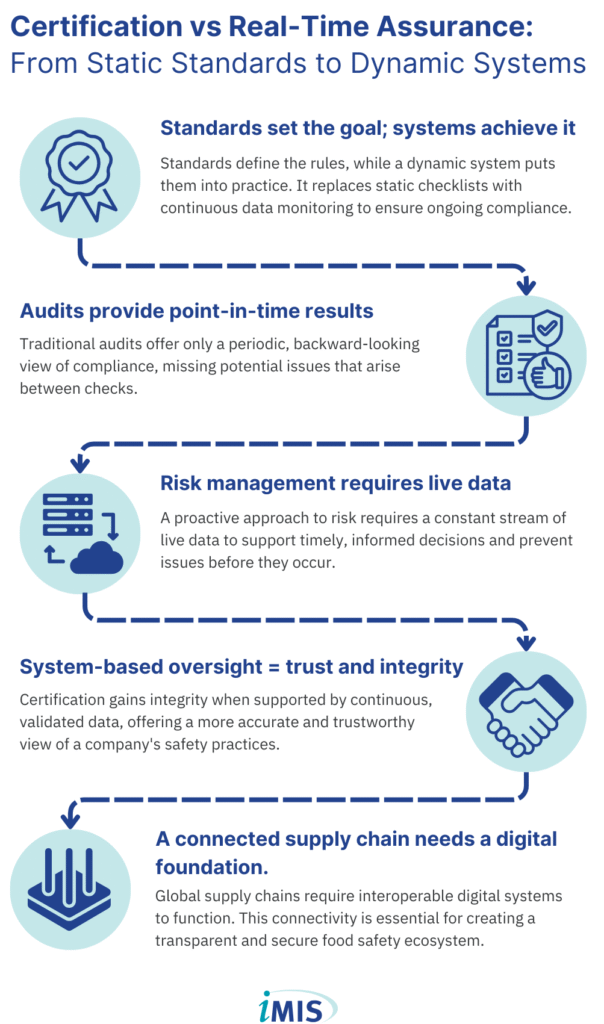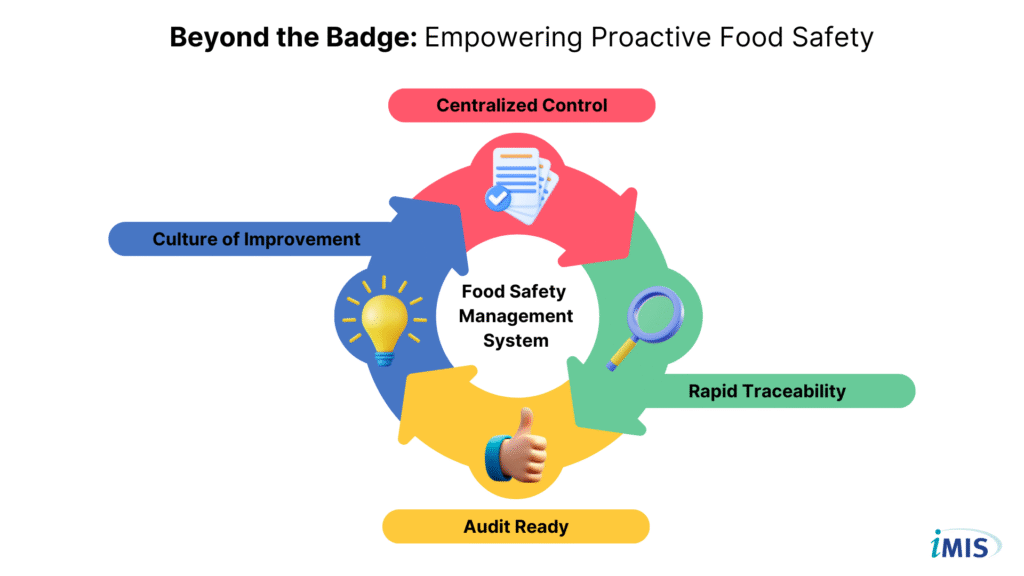In today’s complex global food market, consumers and businesses alike rely on certification to signal quality, safety, and ethical practices. From “organic” to “fair trade,” these labels are meant to provide assurance and build trust. But what happens when the seal of approval on the packaging doesn’t tell the whole story?
While certifications play a role in upholding standards, an over-reliance on them can be a risky strategy. This article explores the limitations of food safety and quality certifications, delves into major scandals that occurred under the watch of certified companies, and discusses how a more holistic approach, empowered by modern tools, can lead to a safer and more transparent food system.
The Cracks in the System: 8 Pitfalls of Relying on Certification
Certifications provide a useful starting point for assessing a product, they are far from a perfect system. Relying on them exclusively can create a false sense of security. Several inherent limitations can obscure the full picture of a product’s journey from farm to table.
1. Limited Scope
Certifications are often narrowly focused. An ‘organic’ label, for example, addresses farming methods but might say nothing about labor rights, water usage, or the carbon footprint of transportation. They provide a snapshot, not the full picture of a company’s ethical or environmental practices.
2. Certification Loopholes
Some producers game the system by meeting the bare minimum requirements to get a label, without truly embracing the principles behind it. Furthermore, the high cost of certification can lead smaller businesses to cut corners or chase labels purely for their marketing value rather than making substantive improvements.
3. Inconsistent Standards
Standards can vary dramatically between countries and even different certifying bodies within the same region. What qualifies as ‘organic’ or ‘fair trade’ in one market might not meet the criteria in another, creating confusion and inconsistency for consumers in a global marketplace.
4. Evolving Consumer Expectations
Today’s consumers demand transparency and the story behind their food. A static certification label cannot convey the nuances of a company’s commitment to sustainability, animal welfare, or innovative waste reduction practices that shoppers increasingly value.
5. Supply Chain Complexity
A certification often applies to just one link in a vast supply chain. A product from a certified farm might still have a hidden background of high transportation emissions, poor labor conditions at a processing plant, or unsustainable packaging.
6. Potential for Complancency
Once certified, some companies treat the label as a finished task rather than a commitment to continuous improvement. The certification can become a simple marketing badge, stifling the motivation for ongoing innovation in safety and sustainability.
7. Lack of Local Context
A “one-size-fits-all” global certification might be irrelevant or even misleading in a local context. What is considered a sustainable or ethical practice can differ greatly depending on the local culture, geography, and scale of the farming operation.
8. Eroding Trust and Transparency
Consumer skepticism towards labels is growing, particularly when large corporations influence the standards. Certifications often lack full transparency into how standards are enforced, who conducts the audits, and how conflicts of interest are managed.
In conclusion, these pitfalls demonstrate that while certifications can serve as a baseline indicator, they are not a guarantee of quality or safety. They often fail to capture the complexity of the global food system and can sometimes mask more significant issues.
This challenge is further complicated as the certification and TICC (Testing, Inspection, Certification, and Compliance) market in Europe transforms into a monopoly, which could put the integrity of the entire system at risk. A deeper commitment to transparency is therefore more critical than ever.
When Certification Fails: Notable Food Safety Scandals
History is full with examples of food safety scandals that have occurred in companies that were certified and seemingly compliant with regulations. These incidents serve as stark reminders that a certificate on the wall is no guarantee of safety.
- Peanut Corporation of America (PCA) Salmonella Outbreak (2008-2009): PCA caused a massive Salmonella outbreak that killed nine people and sickened over 700 by knowingly shipping contaminated products. Despite being subject to FDA inspections and issuing its own “Certificates of Analysis,” the scandal exposed the deadly failure of a system reliant on self-policing and infrequent checks.
- Hallmark/Westland Meat Packing Company Beef Recall (2008): This was the largest beef recall in U.S. history, triggered not by contamination, but by the inhumane treatment of cattle to pass USDA inspections. The company, a supplier to the National School Lunch Program, showed how periodic audits can completely miss ongoing operational and ethical violations.
- Chinese Milk Scandal (2008): The trusted and certified Sanlu Group caused the deaths of six babies by adding melamine to infant formula to fake protein levels. This incident revealed that a company’s stellar reputation—even one that earns it exemptions from government inspections—is no defense against deliberate fraud within a complex supply chain.
From Static Checklists to Dynamic Systems: The Future of Assurance
The shortcomings of traditional certification are leading to a fundamental shift in the food safety industry. The focus is moving away from periodic checks and toward continuous, real-time assurance. This evolution from static standards to dynamic systems is critical for building a truly resilient food supply chain.
- Standards vs. Systems: Standards on paper define requirements, but a functioning digital system brings them to life. Real-time data collection and monitoring require a dynamic compliance system, not a static checklist.
- Beyond Point-in-Time Audits: Audits provide a snapshot—a result on a single day. Without a live system, compliance remains a retrospective and periodic exercise, missing the day-to-day operational reality.
- Risk Management with Live Data: Effective risk management cannot be based on old data. It requires a constant flow of live system inputs to support critical, real-time decisions.
- Enhancing Integrity with Continuous Data: System-based oversight strengthens the entire process. Certification becomes far more robust when it benefits from a continuous stream of validated data, rather than relying solely on periodic audits.
- Building a Digital Infrastructure: Modern global supply chains and regulatory frameworks depend on interoperability. This requires standardized digital systems that can communicate and share data seamlessly across borders and between partners.

Empowering Companies Beyond Certification: The Role of Food Safety Management Systems
The lesson from these scandals is clear: a reactive, “check-the-box” approach to food safety is not enough. Companies need to be empowered to take ownership of their food safety culture, and this is where modern food safety management systems can make a difference.
Systems like iMIS Food provide a framework for companies to proactively manage food safety and quality. iMIS Food is a software platform that helps companies to:
- Centralize and manage all food safety documentation: This includes everything from HACCP plans and supplier information to cleaning schedules and training records.
- Improve traceability: In the event of a food safety incident, companies can quickly and easily trace products through the supply chain, from farm to fork.
- Streamline audits and inspections: The system helps companies to prepare for and manage audits from certification bodies and regulatory agencies.
- Foster a culture of continuous improvement: By providing real-time data and insights, the system helps companies to identify and address potential food safety risks before they become problems.

By empowering companies with the tools and knowledge they need to manage food safety proactively, we can move beyond a simple reliance on certification and create a more robust and resilient food system.
Conclusion: More Than Just Certification
Ultimately, while certifications can provide a baseline of safety or quality, they don’t address the full complexity of modern food systems. A holistic approach that involves traceability, transparency, and ongoing dialogue between consumers, producers, and regulators is essential for understanding and improving the food business. This may include direct consumer engagement, ethical business practices, sustainable sourcing, and efforts to reduce waste or carbon footprints.
The food industry, as complex as it is, requires a multi-faceted approach—one that goes beyond certification to ensure a healthier, more sustainable, and transparent food system.
Stay Connected: Join our Newsletter!
Ready to learn more? Subscribe to our newsletter for the latest updates, tips, and exclusive content delivered straight to your inbox!
Sources
- Food Safety News. (2013, February 22). Peanut Corporation of America from Inception to Indictment: A Timeline. https://www.foodsafetynews.com/2013/02/peanut-corporation-of-america-from-inception-to-indictment-a-timeline/
- R-CALF USA. (n.d.). Westland/Hallmark: 2008 Beef Recall A Case Study by The Food Industry Center. https://www.r-calfusa.com/wp-content/uploads/food-safety/110804MNCaseStudyLargestMeatRecalls.pdf
- U.S.-China Business Council. (2009, May-June). Ethical Supply Chain Management. https://www.chinabusinessreview.com/ethical-supply-chain-management/
- Wikipedia. (2023, October 26). 2008 Chinese milk scandal. https://en.wikipedia.org/wiki/2008_Chinese_milk_scandal
- Wikipedia. (2023, November 28). Peanut Corporation of America. https://en.wikipedia.org/wiki/Peanut_Corporation_of_America
- Wikipedia. (2023, December 12). Hallmark/Westland Meat Packing Company. https://en.wikipedia.org/wiki/Hallmark/Westland_Meat_Packing_Company
- QAssurance. (n.d.). iMIS Food OS for food safety. https://www.qassurance.com/imis-food-safety-security-software-platform/
Related articles to Why Certification is NOT Enough: Food Safety Scandals at Certified Companies
Many customers and visitors to this page 'Why Certification is NOT Enough: Food Safety Scandals at Certified Companies' also viewed the articles and manuals listed below:
